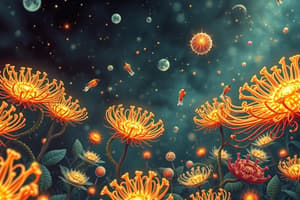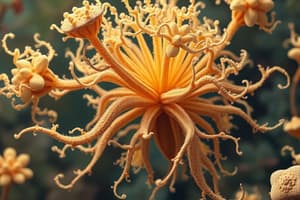Podcast
Questions and Answers
What distinguishes eukaryotic organisms from prokaryotic organisms?
What distinguishes eukaryotic organisms from prokaryotic organisms?
- Eukaryotic organisms can create their own food while prokaryotic cannot
- Eukaryotic organisms reproduce exclusively by binary fission
- Eukaryotic organisms lack a nucleus and enclosed organelles
- Eukaryotic organisms have a nucleus and cell-enclosed organelles (correct)
Why is osmoregulation crucial for amoebas living in freshwater environments?
Why is osmoregulation crucial for amoebas living in freshwater environments?
- It is responsible for movement through pseudopodia
- It allows amoebas to absorb nutrients from the water
- It enables amoebas to eliminate waste products efficiently
- It prevents excess water from causing cell rupture. (correct)
What is the primary role of the food vacuole in amoeba?
What is the primary role of the food vacuole in amoeba?
- To store energy in the form of starch
- To control the cell's water levels
- To digest prey after ingesting it (correct)
- To absorb oxygen from the surrounding environment
Which characteristic is true of heterotrophic organisms?
Which characteristic is true of heterotrophic organisms?
How does amoeba primarily reproduce?
How does amoeba primarily reproduce?
What is the function of pseudopodia in amoebas?
What is the function of pseudopodia in amoebas?
When is the contractile vacuole most active in an amoeba?
When is the contractile vacuole most active in an amoeba?
What describes phagocytosis in amoebas?
What describes phagocytosis in amoebas?
What defines autotrophic organisms?
What defines autotrophic organisms?
Flashcards are hidden until you start studying
Study Notes
Eukaryotic and Prokaryotic Organisms
- Eukaryotic organisms possess a nucleus and cell-bound organelles, distinguishing them from other life forms.
- Prokaryotic organisms lack a nucleus and membrane-bound organelles, typically being single-celled.
Autotrophic and Heterotrophic Organisms
- Heterotrophic organisms cannot synthesize their own food; instead, they obtain nutrients by consuming other organisms.
- Autotrophic organisms can produce their own food through processes like photosynthesis.
Reproduction and Movement in Amoeba
- Amoeba reproduce asexually through binary fission, where the cell divides into two identical daughter cells.
- Pseudopodia enable amoebas to move and capture prey, facilitating locomotion and feeding.
Functions of Vacuoles in Amoeba
- The contractile vacuole regulates osmoregulation, maintaining appropriate water balance within the cell.
- Osmoregulation is the process of controlling cytoplasm or blood concentration, crucial for cellular function.
- The food vacuole secretes acids and digestive enzymes onto prey, killing it and breaking it down for absorption.
Osmoregulation in Different Environments
- The contractile vacuole is more active in freshwater environments due to higher internal cytoplasm concentration compared to the surrounding water.
- In saltwater, the cytoplasm's concentration is balanced with its environment, reducing the risk of cellular bursting.
Phagocytosis Process
- Phagocytosis involves the food vacuole releasing acids to dispatch prey, followed by enzyme secretion for digestion, and absorption of nutrients into the cytoplasm.
Diseases Associated with Amoeba
- Amoeba can cause diseases such as malaria and sleeping sickness, indicating their impact on human health.
Studying That Suits You
Use AI to generate personalized quizzes and flashcards to suit your learning preferences.




